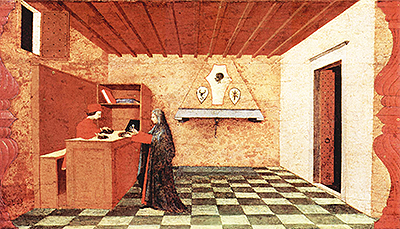Scene One from The Miracle of the Desecrated Host is one of a series of six images that represents the antisemitic story of the desecration of the bread consecrated in the Eucharist.
Scene One is the first in the series and represents a woman selling the Host to a Jewish merchant. The remaining five panels tell of the bleeding of the Host and thus the punishment of the woman and the Jewish merchant, and consequently his family also. Paolo Uccello painted these panels between 1465 and 1469. The beginning scene is 43 cm (16.9 ″) x 58 cm (22.8 ″) and, like many fifteenth century paintings, is made from tempera. This is a method of emulsifying colour using water and egg yolk to create the consistency required. These panels were commissioned for the Confraternity of the Corpus Domini; a major patron of Renaissance painting during the 1400's.
The panels were to reside at the alter of the Confraternity. They also commissioned artwork from the Belgian painter Joos van Wassenhove, which eventually became known as The Institution of the Eucharist. This narrative style evident throughout the church. Scene One opens up the story of the tale Paolo Uccello is trying to portray through his artwork. His charming fairytale style gives a unique perspective to the morbid tale of the anti-Semitic persecution being represented in these images. However, it does show Uccello's ability to be able to experiment with narrative. He also used linear perspective to create single vanishing points and virtual horizons like no artist had done before.
The Miracle of the Desecrated Host was moved from the Confraternity of the Corpus Domini to Santa Agatha and then to Scolopi College where it became lost until 1858. Upon its discovery in a barn, it was revalued and moved to Ducal Palace. The series of six paintings now reside at Galleria Nazionale delle Marche in Urbino, Italy. Its movements through the centuries had damaged the original images of the six panels and thus needed to restored in 1954 to their original state.




